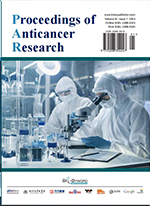Abstract
Objective: To explore the expression of CD151 in gastric cancer tissues and its clinical significance. Methods: Immunohistochemistry was employed to detect the expression of CD151 in gastric cancer tissues and adjacent normal tissues.The relationship between CD151 expression and the clinicopathological characteristics of gastric cancer was analyzed. Results: The expression of CD151 in gastric cancer tissues was significantly higher than in adjacent normal tissues (P <0.05). It was associated with the degree of differentiation, depth of invasion, lymph node metastasis, and TNM staging ofgastric cancer. The survival time of patients with high CD151 expression was significantly shorter than that of those withlow expression (P < 0.05). Conclusion: High expression of CD151 in gastric cancer tissues is correlated with the malignantbiological behavior of gastric cancer and can serve as an indicator for evaluating the prognosis of gastric cancer.
References
Qu F, Hu Y, Zhu B, et al., 2023, Expression of WDR27 in Gastric Cancer Tissues and Its Clinical Significance. Communications Medicine, 37(1): 20–23.
Yuan S, Yu W, Kong X, 2023, Expression of OGDHL and BRCA2 Proteins in Gastric Cancer Tissues and Their Clinical Significance. Progress in Modern Chinese General Surgery, 26(2): 126–130.
Cui N, Wang Y, Shan Y, et al., 2023, Expression of BCCIP Protein in Gastric Cancer Tissues and Its Clinical Significance. Chinese Experimental Diagnostics, 27(1): 76–80.
Wang R, Wu N, Chen W, et al., 2022, Expression of GOLPH3 and VEGF in Gastric Cancer Tissues and Their Clinical Significance. Chinese Experimental Diagnostics, 26(9): 1265–1268.
He X, Chen D, Zhou J, et al., 2021, Analysis of ATM Expression in Gastric Cancer Tissues and Its Clinical Significance Based on Bioinformatics Data. Chinese Journal of Oncology Biotherapy, 28(7): 714–720.
Jia C, Xie Y, Zhang H, et al., 2019, Expression of CD151, c-Met, and Integrin ?3 in Gastric Cancer Tissues and Their Relationship with Clinicopathological Characteristics. Shandong Medicine, 59(5): 65–67.
Weng W, Zhang J, Huang Y, et al., 2014, Clinical Significance of Tetraspanin CD151 Expression in Gastric Cancer Tissues. Hainan Medicine, 25(21): 3245–3247.
Li L, Wu W, Li X, et al., 2014, Preliminary Study on the Correlation Between CD151 Protein Expression in Gastric Cancer Tissues, TCM Syndrome Types, and Gastric Cancer Metastasis. Chinese Journal of Traditional Chinese Medicine, 29(10): 3193–3197.
Wang K, Liu X, Wang F, et al., 2012, Expression of Tetraspanin Molecule CD151 in Gastric Cancer Tissues and Its Relationship with Clinical and Pathological Characteristics. Modern Oncology, 20(8): 1642–1646.
Wang K, 2012, Expression of Tetraspanin Molecule CD151 in Gastric Cancer Tissues and Its Relationship with Clinical and Pathological Characteristics, thesis, Anhui Medical University.
Xu Z, Feng J, Yuan L, et al., 2016, Expression Changes and Significance of HGF, c-met, and VEGF Proteins in Esophageal Cancer. Shandong Medicine, 56(1): 9–11.
Yu S, Wang H, 2022, Research Progress on Members of the Tetraspanin Superfamily and Tumors. Chinese Journal of Cell Biology, 44(4): 672–681.
Liu S, Tao L, Ma X, 2022, Correlation Between CD151 and ERK1 Protein Expression and Related Pathological Parameters in Patients with Gastric Cancer. Henan Medical Research, 31(3): 464–467.
Cai J, Yin Y, 2019, Expression of CD151 and CD163 in Breast Cancer Tissues and Their Clinical Significance. Modern Oncology, 27(17): 3060–3064.
Zhang G, 2019, Expression and Significance of CD151 in Bladder Cancer. Shaoxing Shangyu People’s Hospital, Zhejiang Province.
